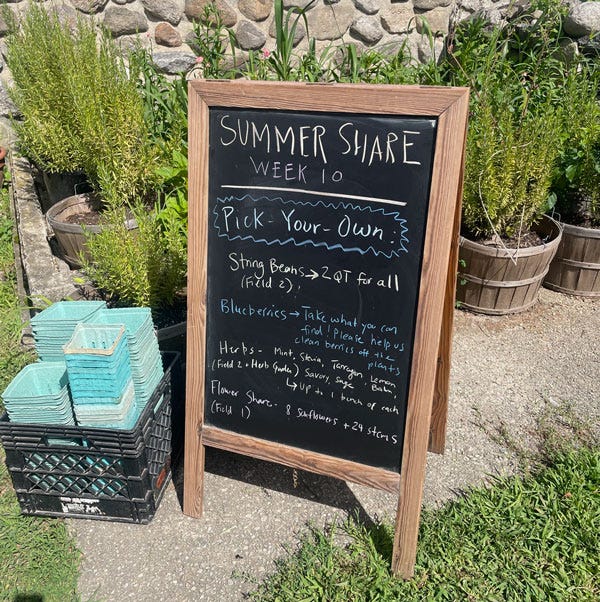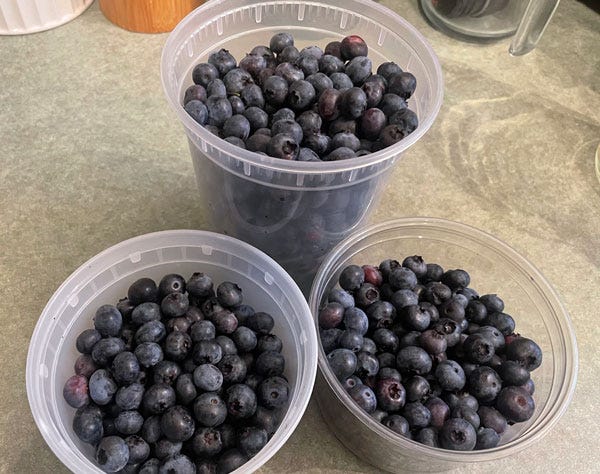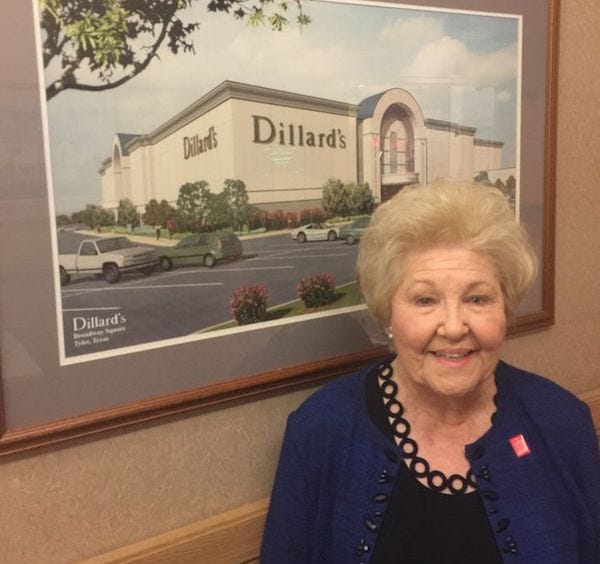Wednesday Walk: 74 Year Career
The longest serving Dillard's employee, sonic identities, and the sudden end of blueberry season
Welcome to Willoughby Hills!
If you enjoy what you’re reading, please consider a free subscribtion to receive emails every Wednesday and Sunday plus podcast episodes every two weeks. There are also paid options, which unlock even more features.
As is typical every Wednesday, I’m bring you a smattering of topics that I hope will make you a bit more curious about the world around you and give you something to think about later. I call these Wednesday Walks, as it’s the type of conversation we might have walking down a path in the woods. Shall we take a stroll?
It’s Already Over
On Sunday, I wrote about the joys of getting back to Clark Farm in Carlisle, MA to pick blueberries after almost a month away. I mentioned missing the beginning of the season and arriving right in the middle of an abundance of blueberries, where ripe berries were on every bush and easy to pick.
The day after I published that piece, I got an email from Clark Farm about this week’s CSA share, and it turns out that the blueberry season that I thought I had walked into the middle of is already nearly over. Here’s what the email said:
“This is the last week of [pick your own] blueberries, and we’d love your help cleaning the blueberry plants. You’re welcome to take any berries you can find. If you are picking, please work down low on the plants (often these berries get missed) and harvest all berries — even small ones — as this will help our blueberry plants to stay healthy for next year.”
I was hoping to savor the season a little longer, but I am also grateful for unlimited berries! I don’t recall this happening in year’s past. It was a pretty rainy month, with some farms in Vermont and Western Massachusetts flooding. It didn’t get that bad here, but I wonder if the rain helped produce a more prolific crop than usual.
I’ve often compared joining a CSA to investing in a farm for a season. In times of drought, pests, or disease, the return on that investment may be lower. But in times of abundance, the shareholders receive a nice dividend in the form of extra crops.
My kids and I went to the farm yesterday afternoon to get one last blueberry fix. It took the three of us about 30 minutes to harvest 2 quarts. The experience of picking berries for fun like this always makes me think of the farm workers that do this for a living, day in and day out.
While there are mechanical solutions to harvesting blueberries on larger farms, blueberries are often still picked by hand because of their delicate nature. Workers are paid by how much they pick, earning about 50¢ per pound. Granted, I was working with two children and was more focused on quality than quantity, but I would not get rich as a farm laborer. Frankly, I marvel at the skill of the people that bring food to our table, whether at the local scale or the industrial scale.
The blueberries we picked will get frozen and used throughout the winter, mostly as an addition to smoothies, muffins, and other treats.
74 Years of Service
I’ve written a lot about department stores in this newsletter over the years, from talking about the Filene’s and Jordan Marsh stores in Downtown Boston to touring one of the handful of Sears stores still in existence.
I recently came across an interesting little article in Southern Living about Melba Mebane, a woman from Texas who retired from Dillard’s after 74 years. Yes, 74 years. She is considered the chain’s longest serving employee.
According to Southern Living:
“Melba Mebane began her career in 1949 as an elevator operator at Mayer & Schmidt, which later became Dillard’s in 1956. She was just 17 years old. Mebane, now 90, worked in several departments at the store.”
Mebane worked at the store in Tyler, Texas in the fragrance department. But what’s interesting to me is how she watched the chain evolve over time. When she started at Mayer & Schmidt in Tyler, Dillard’s itself was only 11 years old. The company these days has close to 300 stores, but Mebane knew it when it was a small, family company. Again quoting from Southern Living:
“In addition to her official duties behind the fragrance counter, Terry Mebane said his mother also used to ‘corral’ the five Dillard children when their father—and founder of the chain—William Dillard came to Tyler. One of those children, Drue Dillard Matheny, now serves as vice president of the company. She’s known Melba for 65 years and was there to help celebrate her retirement.”
It’s wild for me to think about how much the department store has changed in my lifetime. I can only imagine what it’s been like to witness those changes across 74 years and from the day to day perspective of an employee.
Hats off to Melba for her service and wishing her a happy retirement!
Themed Notes
Finally this week, I wanted to share an interesting article in The Washington Post by classical music critic Michael Andor Brodeur. Brodeur explores the new phenomenon in marketing of something called the “sonic identity,” a progression of a few notes meant to identify a brand:
“Think of them as highly concentrated jingles. You hear one when you press the ignition button in your car. You hear one when Alexa does what you ask. You hear one when you turn on your TV or restart your laptop. You hear one when you successfully tap your phone to pay. (MasterCard’s percussive celebration of transactional acceptance makes spending money you don’t have sound like winning a prize.)
And since the smartphone era introduced us to the concept of a ringtone, more and more companies have been relying on these nano-melodies to ensure that their brand stays on your mind, and they are absolutely everywhere. Like bits of digital birdsong, they’re contrived and designed to create an ambient environment of naturalistic consumer comfort, full of reassuring reminders of fleeting satisfaction. They’re also meant to sweep up the shards of our shattered attention spans.”
I like that Brodeur calls out not only the more obvious sonic identities like the Netflix “ta-DUM” but also the more obscure ones, like the sounds that our cars and appliances make.
(Although, some of these more modern appliances play a practical symphony, like Samsung washers when they reach the end of a cycle, as has been spoofed on TikTok)
 Tiktok failed to load.
Tiktok failed to load.Enable 3rd party cookies or use another browser
Brodeur also makes the comparison between these new sonic identities and the jingles of yesteryear.
I was amazed when my wife and I showed our kids a Rugrats VHS tape in our RV recently (our RV is from 2006 and came equipped with a combination DVD/VHS player). There was a Nickelodeon trailer on the tape featuring other Nick Toons and we both, almost subconsciously, began singing along to every word and quoting the dialogue from the shows that were used.
That one minute of nearly 30 year old Nickelodeon promo is lodged in some part of our brains that we didn’t even realize was there. (Here’s the link for you fellow Millennials):
These sonic identities aren’t just used in advertising- even the TV theme song is subject to them. When Friends debuted in 1994, its theme song was nearly a minute long and was later turned into a three minute pop song. By contrast, Curb Your Enthusiasm and The Good Place both have opening themes that are mere seconds long.
I do marvel at how a handful of notes can sometimes be just as effective as a full theme song and am impressed by the teams that can turn two measures of music into something recognizable. For me, the State Farm notes, themselves a distillation of the longer theme song, tend to immediately grab my attention like a Pavlovian bell. I hear it on YouTube preroll spots, radio commercials, and Pandora interstitials. It works. But imagine the writing process to get to that point. How do you turn two to five notes into something fully unique? Sometimes we think we need something longer to make our point, when something simple will do. The Home Depot or Bed Bath and Beyond are good names for businesses, but so are A&P or X. Well, maybe not X. But you get the idea.
Brodeur makes the comparison between these little micro songs and other pollutants in our culture:
“The deep listener in me is unsettled by the growing chorus of ad bugs, those barely perceptible bits of consumer culture, absorbed through our ears like the audio equivalent of microplastics.”
What are your thoughts on sonic identities and micro themes? Are there any that you think work well? Any that really annoy you? I’m curious to hear your thoughts.
I publish new issues every Wednesday and Sunday. Sign up to always receive the latest issue and support my work:
Other Wednesday Walks
If you’ve missed past issues of this newsletter, they are available to read here.








